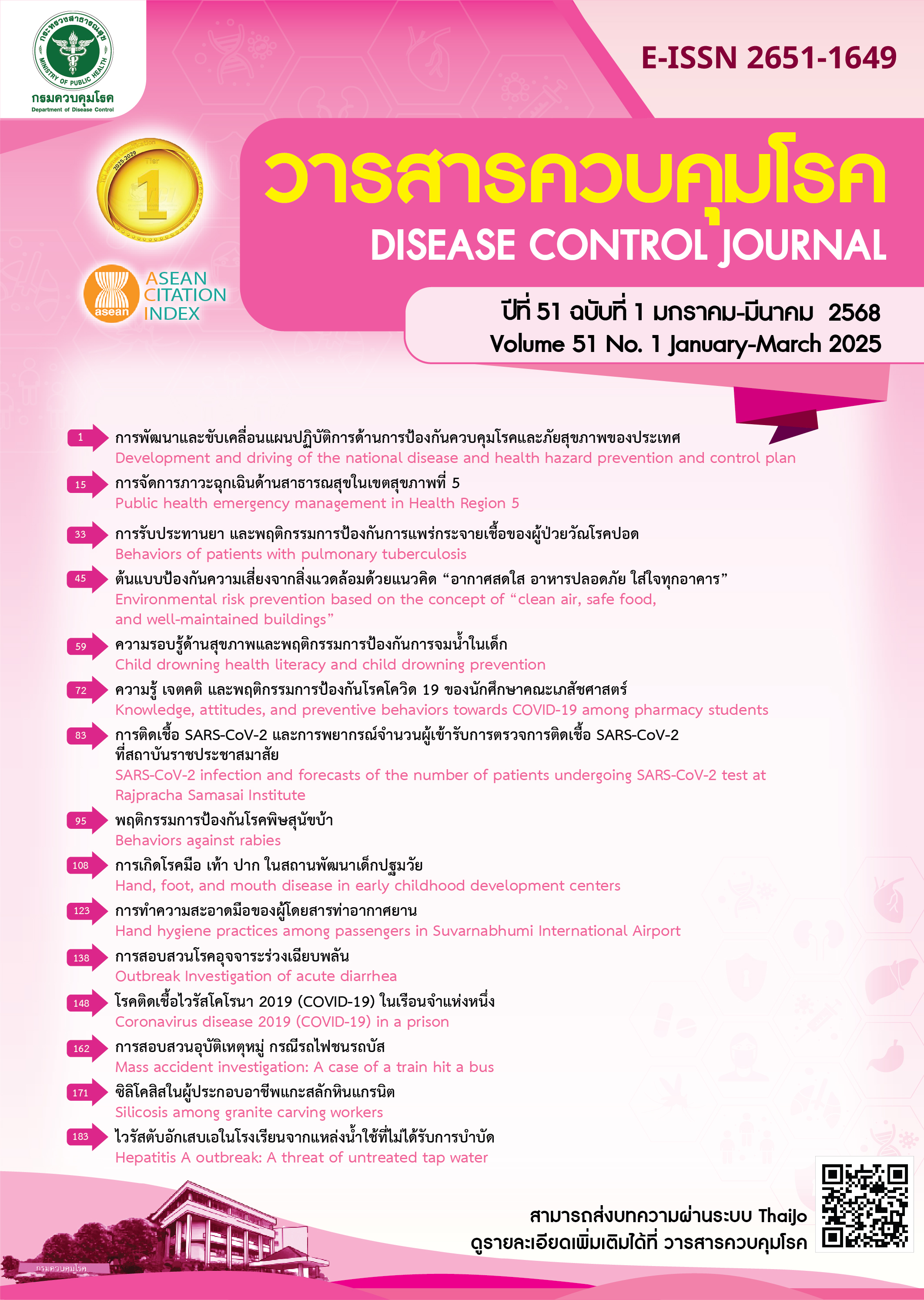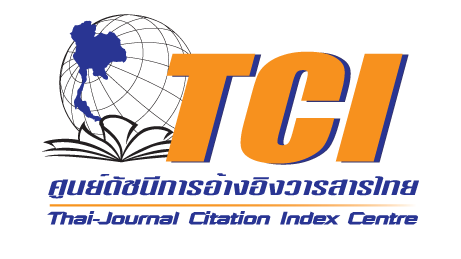Health literacy and preventive behaviors against rabies among residents of Chuen Chom District, Maha Sarakham Province, 2023
DOI:
https://doi.org/10.14456/dcj.2025.8Keywords:
health literacy, rabies, health behaviorsAbstract
This cross-sectional descriptive study aims to assess the level of health literacy among residents in areas with continuous rabies outbreaks in animals and reported human bite cases in Chuen Chom District, Maha Sarakham Province. The study was conducted using a questionnaire with a sample of 215 participants. The study found that 90.2% of the respondents were female, and 61.8% were aged 51 years and older. Regarding education, 75.3% had completed secondary school, vocational certificate, or diploma levels. Overall, 38.6% of the participants had an insufficient level of health literacy, with decision-making skills being the most problematic area. In terms of rabies knowledge, 49.8% had a moderate level, while 33.0% had a very good level of understanding. Regarding rabies prevention behaviors, 67.4% demonstrated excellent preventive practices. The most common source of rabies prevention information was healthcare personnel (81.4%). The findings highlight the urgent need to enhance rabies-related health literacy among the public. Public health agencies, in collaboration with relevant networks, should establish accessible and accurate information databases. Recommendations: 1) Improve all five aspects of health literacy among residents in high-risk areas; 2) Increasing rabies prevention campaigns in order to correct common misconceptions about rabies, such as the belief that all rabid dogs are aggressive and that rabies is a curable disease.
Downloads
References
World Health Organization. Rabies: WHO fact sheet on rabies providing key facts and information on symptoms, diagnosis, transmission, post-exposure prophylaxis, local treatment, prevention, WHO response [Internet]. 2019 [cited 2019 Jul 27]. Available from: https://www.who.int/health-topics/rabies#tab=tab_1
The Center for Food Security & Public Health. Rabies and rabies-related lyssavirus [Internet]. 2012 [cited 2019 Jul 27]. Available from: http://www.cfsph.iastate.edu/Factsheets/pdfs/rabies.pdf
Heyman DL, editor. Control of communicable diseases manual. 19th ed. Washington DC: American Public Health Association; 2008. p.477-85.
World Health Organization. Rabies vaccines and immunoglobulins: WHO position 2017 [Internet]. 2019 [cited 2019 Jul 27]. Available from: https://www.who.int/publications/i/item/WHO-CDS-NTD-NZD-2018.04
General Communicable Diseases Division, Department of Disease Control, Ministry of Public Health. Guidelines for the prevention and control of rabies [Internet]. 2017 [cited 2024 Jan 27]. Available from: https://ddc.moph.go.th/uploads/publish/1375520230123084931.pdf (in Thai)
Ministry of Public Health (TH), Department of Disease Control, Bureau of Epidemiology. DDC Watch, Year 3, Issue 3, March 2016: Rabies, a hidden danger [Internet]. Available from: http://203.157.15.110/boe/getFile.php?id=MzQ4&lbt=YmZk&rid=ZmlsZXNfdXBsb2FkL25ld3M (in Thai)
Bureau of Epidemiology (TH), Department of Disease Control, Ministry of Public Health. Rabies situation report [Internet]. [cited 2024 Aug 1]. Available from: https://odpc7.ddc.moph.go.th/upload_files/20180703160724.pdf (in Thai)
Office of Disease Prevention and Control 9, Nakhon Ratchasima. Rabies situation update [Internet]. [cited 2024 Aug 1]. Available from: https://ddc.moph.go.th/odpc9/news.php?news=37788&deptcode=odpc9&news_views=2565 (in Thai)
Department of Livestock Development. Rabies Surveillance Information System [Internet]. Available from: http://www.thairabies.net/trn/ (in Thai)
Department of Disease Control (TH), Bureau of Risk Communication and Behavioral Development. Health literacy assessment on disease prevention and control among the Thai population 2021 [Internet]. [cited 2022 Sep 1]. Available from: https://datariskcom-ddc.moph.go.th/download/การประเมินความรอบรู้ด้-6/ (in Thai)
Department of Health (TH), Health Systems Research Institute, Mahidol University. Health literacy survey report for the population aged 15 years and older 2017 (Phase 1) [Internet]. 2018 [cited 2022 Feb 17]. Available from: https://borc.anamai.moph.go.th/web-upload/24xe82d9421a764bd38b31a4171c44f37a6/tinymce/KPI/2565/KPI1_36/L2/1KPI1-36_2-2-8.pdf (in Thai)
World Health Organization. Health literacy and health promotion: definitions, concepts and examples in the Eastern Mediterranean Region. 7th Global Conference on Health Promotion, promoting health and development; 2009; Nairobi, Kenya
Sorensen K, Van den Broucke S, Fullam J, Doyle G, Pelikan J, Slonska Z, et al. Health literacy and public health: a systematic review and integration of definitions and models. BMC Public Health. 2012;12:80.
Pelikan JM, Dietscher C. Developing health literate health care organizations to better empower patients for co-producing health: from health literacy to health literate health care organizations (HLHCO). Ludwig Boltzmann Institute, Health Promotion Research; 2020 Jan 21 [Internet]. [cited 2021 Dec 18]. Available from: http://www.nationalacademies.org/hmd/Reports/2004/
Kaewdumkuang K. K-shape 5 skills to enhance health literacy [Internet]. 2020 [cited 2020 Sep 1]. Available from: http://hepa.or.th/journal.php (in Thai)
The Department of Local Administration. Chuenchom District (TH), Mahasarakham population [Internet]. [cited 2019 Jun 15]. Available from: https://dopacrr.dopa.go.th/plan_develop/app/main/upload/2564/25644413_1.pdf (in Thai)
Daniel WW. Biostatistics: A Foundation for Analysis in the Health Sciences. 7th edition. New Jersey: John Wiley & Sons; 1999.
Kaewdumkuang K. Health Literacy Assessment Tools. Health Educational Professional Association. 2021;36(2):7-18. (in Thai)
Sorensen K, Van den Broucke S, Fullam J, Doyle G, Pelikan J, Slonska Z, et al. Health literacy and public health: A systematic review and integration of definitions and models. BMC Public Health [Internet]. 2012 [cited 2021 Dec 18];12:1-13. Available from: https://doi.org/10.1186/1471-2458-12-80
Bloom BS, Madaus GF, Hastings JT. Handbook on formative and summative evaluation of student learning. New York: McGraw-Hill; 1971.
Likert R. The Human Organization: Its Management and Value. New York: McGraw-Hill, 1967.
Best JW. Research in Education. 3rd ed. Englewood Cliffs, New Jersey: Prentice-Hall, 1977.
Polit DF, Beck CT, Owen SV. Is the CVI an acceptable indicator of content validity? Appraisal and recommendations. Res Nurs Health. 2007;30(4):459-67.
Health Education Division, Department of Health Service Support, Ministry of Public Health. Health Literacy. Bangkok: Cooperative League of Thailand; 2013. (in Thai)
Juthong H, Yoksakul W. Results of a survey of public awareness of rabies in risk areas, Trang Province, Phatthalung, Songkhla. Thai Journal of Public Health and Health Sciences. 2020; 3(1):81-7. (in Thai)
Pisek S, Kamsai A. Rabies outbreak and knowledge, attitudes, and behaviors regarding rabies prevention and control among residents in outbreak areas, Maha Sarakham Province, March 2014-March 2017. Bangkok: Bureau of Disease Prevention and Control, Department of Livestock Development; 2018. (in Thai)
Medley AM, Millien MF, Blanton JD, Ma X, Augustin P, Crowdis K, et al. Retrospective cohort study to assess the risk of rabies in biting dogs, 2013-2015, Republic of Haiti. Trop Med Infect Dis. 2017;2(1):14.
Wongphrueksasung V, Boonyo K. Rabies situation in animals in Thailand from 2014 to 2016. Bangkok: Bureau of Disease Prevention and Control, Department of Livestock Development; 2017. (in Thai)
Yongguen R, Khuma-Hiran N. Analysis of risk factors for recurrent rabies in dogs in Kalasin Province, 2017-2018 [Internet]. [cited 2024 Nov 11]. Available from: https://region4.dld.go.th/webnew/images/stories/vichakarn/64/64_3_1.pdf (in Thai)
World Health Organization (WHO). Guidelines for dog rabies control [Internet]. [cited 2024 Nov 1]. Available from: https://www.who.int/teams/control-of-neglected-tropical-diseases/rabies.
Downloads
Published
How to Cite
Issue
Section
License
Copyright (c) 2025 Disease Control Journal

This work is licensed under a Creative Commons Attribution-NonCommercial-NoDerivatives 4.0 International License.
Articles published in the Disease Control Journal are considered as academic work, research or analysis of the personal opinion of the authors, not the opinion of the Thailand Department of Disease Control or editorial team. The authors must be responsible for their articles.


.png)



